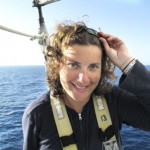
Research Associate Professor and Senior Lecturer of Biology
Twitter: @RandiRotjan
Courses Taught:
Current Research
Our research focuses on various ecological processes governing marine ecosystem structuring. Many of these processes touch on areas of symbiosis, behavioral ecology, and conservation biology. We use exploratory observations combined with manipulative experiments across multiple ecological levels, working to unite mechanistic patterns at the ecosystem, community, population, and organismal levels. Specifically, we integrate field observations in the Central Pacific, Caribbean, and New England with lab experiments focused on organismal physiology and ecology, largely focused on coral reef ecosystems and organisms.
The lab focuses heavily on marine protected areas (specifically the Phoenix Islands Protected Area [Kiribati] and the Southwater Caye Marine Reserve [Belize]), coral physiology and organismal biology with tropical and temperate species, and on behavioral ecology of tropical marine invertebrates, including corals and crustaceans. Our lab has a growing interest in the comparing wild versus urban and coastal ecosystems.
Selected Publications
- Rotjan RD, Sharp K, Gauthier A, Yelton R, Baron Lopez E, Carilli J, Kagan J, Urban-Rich J (2019) Patterns, dynamics, and consequences of microplastic ingestion by the temperate coral, Astrangia poculata: a potential biomarker for microplastic pollution. Proceedings of the Royal Society B 286(1905): 20190726.
- Kennedy BRC, Cantwell K, Malik M, Kelley C, Potter J, Elliot K, Lobecker M, Sowers D, White M, France S, Mah C, Auscavitch S, Rotjan RD (2019) The unknown and the unexplored: Quantifying what we now know, and still don’t know, about the Pacific deep-sea following the 3-year NOAA CAPSTONE Expeditions. Frontiers in Marine Science. DOI: 10.3389/fmars.2019.00480.
- Hernandez C, Witting J, Willis C, Thorrold S, Llopiz J, Rotjan RD (2019) Evidence and patterns of tuna spawning inside a large no-take Marine Protected Area. Scientific Reports 9: 10772.
- Hanich Q, Rotjan RD, Aqorau T, Bailey M, Campbell B, Cisneros A, Cheung W, Gray N, Gruby R, Hampton J, Parris H, Reid C, Sumaila R, Schwartz W, Temari T (2018) Unravelling the Blue Paradox: Incomplete analysis yields incorrect conclusions about PIPA closure”, Letter, Proceedings of the National Academy of Sciences (PNAS). DOI: 10.1073/pnas.1815600115.
- Burmester E, Breef-Pilz A, Lawrence N, Kaufman L, Finnerty J, Rotjan RD (2018) The impact of autotrophic versus heterotrophic nutritional pathways on colony health and wound recovery in corals. Ecology and Evolution 8 (22): 10805-10816.
- Goss HA, Jaskiel JE, Rotjan RD (2018) Thalassia testudinum as a potential vector for incorporating microplastics into benthic marine food webs. Marine Pollution Bulletin (135): 1085-1089.
- Burmester EM, JR Finnerty, L Kaufman, Rotjan RD (2017) Temperature and symbiosis affect lesion recovery in experimentally wounded facultatively symbiotic temperate corals. Marine Ecology Progress Series. 570: 87-99.
- DeFilippo L, EM Burmester, L Kaufman, Rotjan RD (2016) Patterns of surface lesion recovery in the northern star coral, Astrangia poculata. Journal of Experimental Marine Biology and Ecology. 481: 15-24.